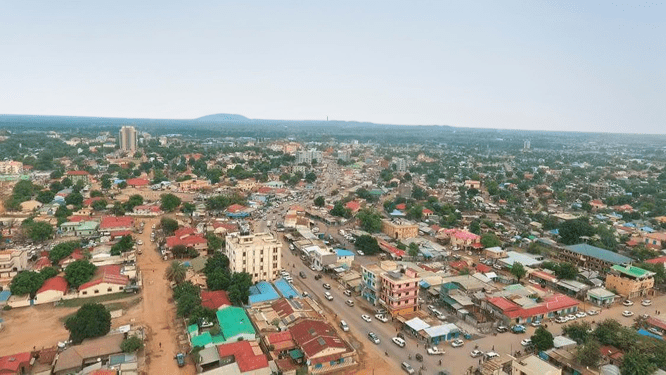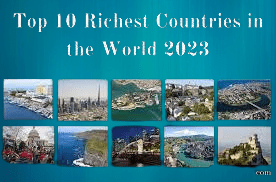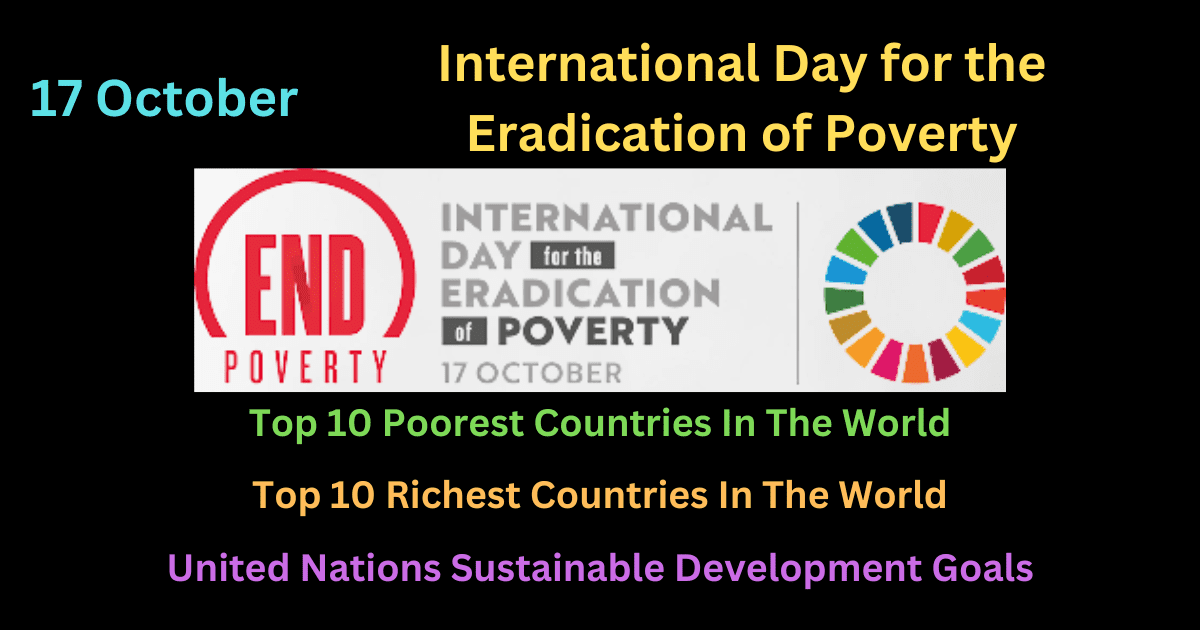WORLD Day for the Eradication of Poverty: International Day for the Eradication of Poverty is observed every year on October 17 globally. Eradication of Poverty day is observed to raise awareness about the global issue of poverty and how it is a violation of human rights and of human dignity.
WORLD Day for the Eradication of Poverty
The International Day for the Eradication of Poverty can be traced back to 17 October 1987, to commemorate the victims of extreme poverty, violence and hunger. More than a hundred thousand people gathered at the Trocadéro in Paris. This was where the Universal Declaration of Human Rights was signed in 1948 to honour the victims of extreme poverty, violence and hunger. The International Day for the Eradication of Poverty is also called as the World Day for the Eradication of Poverty

They declared poverty as a violation of human rights and stated the need to come together and remedy this situation. A commemorative stone was unveiled, with these convictions. Replicas of this commemorative stone have been found around the world, where people gather every year on October 17 to mark the International Day for the Eradication of Poverty.
On December 22, 1992, the United Nations General Assembly, through resolution 47/196 declared 17 October as the International Day for the Eradication of Poverty.
In a world characterized by an unprecedented level of economic development, technological means and financial resources, that millions of persons are living in extreme poverty is a moral outrage. Eradication of Poverty is not solely an economic issue, but rather a multidimensional phenomenon that encompasses a lack of both income and the basic capabilities to live in dignity.
Persons living in poverty experience many interrelated and mutually reinforcing deprivations that prevent them from realizing their rights and perpetuate their poverty, including:
- dangerous work conditions
- unsafe housing
- lack of nutritious food
- unequal access to justice
- lack of political power
- limited access to health care
What is Poverty?
As we know that poverty has many faces, it changes from place to place. For some poverty is hunger, lack of shelter, being sick or not having enough money, etc. Basically, poverty is a state or condition in which a person lacks financial resources and not able to fulfill basic needs.
Poverty-stricken people and families live without a home, clean water, healthy food, and medical attention. Therefore, International Day for the Eradication of Poverty highlights the problems faced by poverty-stricken people or families and works towards eradicating poverty globally in all its forms.
According to the United Nations “International Day for the Eradication of Poverty presents an opportunity to acknowledge the effort and struggle of people living in poverty, a chance for them to make their concerns heard and a moment to recognize that poor people are the first ones to fight against poverty”.
Poverty: No Poverty or Eradication of Poverty is the number 1 goal out of the United Nations 17 sustainable development goals.
United Nations Sustainable Development Goals

On 25 September 2015, the 193 United Nations members countries of the UN General Assembly adopted the 2030 Development Agenda titled “Transforming our world: the 2030 Agenda for Sustainable Development.”
The United Nations Sustainable Development Goals (SDGs) or Global Goals are a collection of seventeen interlinked objectives designed to serve as a “shared blueprint for peace and prosperity for people and the planet, now and into the future.”
Implementation of the United Nations Sustainable Development Goals started worldwide in 2016.
Goal 1: End poverty or eradication of poverty in all its forms everywhere
According to the UN “The International Day for the Eradication of Poverty presents an opportunity to acknowledge the effort and struggle of people living in poverty, a chance for them to make their concerns heard and a moment to recognize that poor people are the first ones to fight against poverty”. It is necessary to end poverty everywhere in all its forms. According to the World Bank, poverty is earning less than $1.90 a day.
The International Committee for October 17 was launched in 2008 to promote the International Day for the Eradication of Poverty in its founding spirit. The composition of the committee is unique with members including people with lived experience of extreme poverty and human rights defenders engaged in the fight against poverty and eradication of poverty. Every year, the International Committee engages in a consultation process through the Forum on Overcoming Poverty to select a theme for the International Day for the Eradication of Poverty on October 17 by the UN with input from people with lived experience of poverty.
Eradication of poverty in all its forms remains one of the greatest challenges facing humanity. While the number of people living in extreme poverty dropped by more than half between 1990 and 2015, too many are still struggling for the most basic human needs.
As of 2015, about 736 million people still lived on less than US$1.90 a day; many lack food, clean drinking water and sanitation. Rapid growth in countries such as China and India has lifted millions out of poverty, but progress has been uneven. Women are more likely to be poor than men because they have less paid work, education, and own less property.
Progress has also been limited in other regions, such as South Asia and sub-Saharan Africa, which account for 80 percent of those living in extreme poverty. New threats brought on by climate change, conflict and food insecurity, mean even more work is needed to bring people out of poverty.
In 2023, around 12 percent of the world population in extreme poverty, with the poverty threshold at 1.90 U.S. dollars a day, lived in Nigeria. Moreover, the Democratic Republic of the Congo accounted for around 10 percent of the global population in extreme poverty. Other African nations with a large poor population were Tanzania, Madagascar, and Mozambique.
The World Bank updated the global poverty lines in September 2022. The new extreme poverty line of $2.15 per person per day, which replaces the $1.90 poverty line, is based on 2017 calculations.
Poverty is a widespread issue across Africa. Around 431 million people on the continent were living below the extreme poverty line of 1.90 U.S. dollars a day in 2022. Since the continent had approximately 1.4 billion inhabitants, roughly a third of Africa’s population was in extreme poverty that year. Malawi, Niger, and Tanzania had Africa’s highest extreme poverty rates based on the 2.15 U.S. dollars per day extreme poverty indicator (updated from 1.90 U.S. dollars in September 2022). Although the levels of poverty on the continent are forecast to decrease in the coming years, Africa would remain the poorest region compared to the rest of the world.
Top 10 poorest country in the world
As per Forbes India’s report of 2023, below are the top 10 poorest country in the world.
Despite abundant global wealth, some countries continue to suffer in extreme poverty. Going by GDP per capita country-wise, this article lists the poorest countries in the world in 2023. Before getting into the list of the poorest countries in the world, let’s first understand the concept of GDP per capita and how a country is ranked on this basis.
Methodology for ranking poorest countries in the world
GDP stands for Gross Domestic Product, which measures a country’s goods and services produced yearly. Its population must also be considered to get a clearer picture of how rich or poor a country is. Therefore, divide the GDP by the total number of people in the country to get GDP per capita.

Sometimes, the GDP per capita only tells us part of the story. That’s because the cost of living and inflation rates can vary a lot from one country to another. That is where PPP penetrates to make a fair comparison. PPP stands for Purchasing Power Parity and considers the local costs and inflation rates to give a more accurate picture of the standard of living in different countries.
These are the top 10 poorest country in the world in 2023 by GDP per capita PPP as estimated by International Monetary Fund (IMF) as of August 28, 2023
| Rank | Top 10 poorest country in the world |
| 1 | South Sudan |
| 2 | Burundi |
| 3 | Central African Republic |
| 4 | Somalia |
| 5 | Democratic Republic of the Congo |
| 6 | Mozambique |
| 7 | Niger |
| 8 | Malawi |
| 9 | Chad |
| 10 | Liberia |
South Sudan
- GDP: $3.9 billion
- Population: 11,104,916

South Sudan, the world’s youngest country, gained independence in 2011 but faces significant economic challenges. Political instability, ongoing conflicts, and limited infrastructure hinder its progress. With a majority relying on traditional agriculture, violence and extreme climate events often disrupt farming, perpetuating poverty in this landlocked nation of about 11 million people.
Burundi
- GDP: $3.4 billion
- Population: 13,269,272
Burundi, a small landlocked country in East Africa, confronts significant socio-economic challenges, including political instability, conflicts, and inadequate infrastructure development. The nation’s economic struggles and the hardships faced by its citizens are further exacerbated by rapid population growth. With approximately 80 percent of the population reliant on subsistence agriculture, food insecurity is remarkably high compared to other sub-Saharan African countries.
Central African Republic (CAR)
- GDP: $2.2 billion
- Population: 5,757,091
The Central African Republic (CAR), situated in Central Africa, grapples with profound economic challenges due to political instability, armed conflicts, and inadequate infrastructure. The country’s wealth in gold, oil, uranium, and diamonds contrasts starkly with the widespread poverty experienced by its citizens. The combination of price increases for essential goods following the war in Ukraine and severe flooding and drought cycles has further exacerbated the CAR’s economic struggles.
Somalia
- GDP: $7.5 billion
- Population: 18,192,151
Situated in the Horn of Africa, Somalia has been plagued by years of political instability, armed conflicts, and humanitarian crises. The absence of a functioning central government, limited infrastructure, and widespread poverty have hindered the country’s progress.
Democratic Republic of the Congo (DRC)
- GDP: $42.6 billion
- Population: 102,553,019
The Democratic Republic of Congo, or the DRC, the biggest country in Sub-Saharan Africa, faces profound economic challenges despite its wealth in natural resources like cobalt and copper. Most of the population lives in poverty, with around 62 percent of Congolese living on less than $2.15 a day. Malnutrition, limited access to education and healthcare, and high fertility rates further exacerbate the country’s poverty and development constraints.
Mozambique
- GDP: $3.3 billion
- Population: 33,980,890
Mozambique, a sparsely populated country and a resource-rich former Portuguese colony, faces poverty due to natural disasters, disease, rapid population growth, low agricultural productivity, and wealth inequality. Despite its resource richness and strong GDP growth, the country remains among the world’s poorest, exacerbated by attacks from Islamic insurgent groups in the gas-rich north.
Niger
- GDP: $9.2 billion
- Population: 27,291,636
Niger, a landlocked West African country, faces economic challenges and high poverty rates due to limited natural resources, frequent droughts, and a predominantly agricultural economy. With 80 percent of its territory blanketed by the Sahara Desert and a growing population reliant on small-scale agriculture, desertification poses a significant threat.
Malawi
- GDP: $6.9 billion
- Population: 21,039,999
Despite its beautiful landscapes, Malawi, located in southeastern Africa, grapples with significant economic challenges. The nation relies heavily on rain-fed agriculture, making it vulnerable to climate change and fluctuating commodity prices. Nonetheless, the government remains committed to promoting economic diversification, improving education and healthcare, and reducing poverty.
Chad
- GDP: $10.9 billion
- Population: 18,327,841
Chad, located in Africa, faces significant economic challenges and high poverty rates despite having substantial oil reserves. The nation heavily relies on rain-fed agriculture, which leaves it vulnerable to weather-related shocks and widespread food insecurity. Human rights abuses and crackdowns on political opposition and dissent have been reported, raising concerns about democratic principles.
Liberia
GDP: $10.9 billion
Population: 5,428,692
Liberia’s enduring poverty stems from violent conflicts, including civil wars and outbreaks like Ebola, leading to unstable infrastructure and limited services. Forced migration disrupts agriculture, contributing to food insecurity. International organizations like the World Food Programme strive to alleviate poverty and improve the country’s future through sustainable development efforts and investment in education and healthcare.
Top 10 richest country in the world
|
Top 10 richest country in the world |
Continent | GDP-PPP per capita (in USD) |
| #1 Ireland | Europe | 145,196 |
| #2 Luxembourg | Europe | 142,490 |
| #3 Singapore | Asia | 133,895 |
| #4 Qatar | Asia | 124,833 |
| #5 Macao SAR | Asia | 89,565 |
| #6 United Arab Emirates | Asia | 88,221 |
| #7 Switzerland | Europe | 87,963 |
| #8 Norway | Europe | 82,655 |
| #9 United States | North America | 80,035 |
| #10 San Marino | Europe | 78,932 |

| Rank | Country | GDP-PPP per capita (in USD) |
| 11 | Brunei Darussalam | 75,582 |
| 12 | Hong Kong SAR | 74,602 |
| 13 | Denmark | 73,394 |
| 14 | Taiwan Province of China | 73,343 |
| 15 | Netherlands | 72,976 |
| 16 | Iceland | 69,781 |
| 17 | Austria | 69,501 |
| 18 | Andorra | 69,001 |
| 19 | Germany | 66,134 |
| 20 | Sweden | 65,841 |
Ireland
- GDP: $499 billion
- Population: 5.03 million
After the great financial crisis of 2008, Ireland put a lot of effort into reforming its banking industry. It initiated measures like cuts to public-sector wages to get its economy where it is today. Further, Ireland is one of the largest corporate tax havens in the world, with multinational companies (such as Apple, Google, and Microsoft) adding over 50 percent to the Irish economy in recent years.
Luxembourg
- GDP: $86.7 billion
- Population: 639 thousand
Luxembourg is one of the relatively unscathed European countries to come out of the Covid-19 pandemic. The nation is known for using wealth to ensure better living standards, healthcare, and education for the general populace. Further, the country is one of the biggest tourist destinations in the world, with its idyllic castles, abundant greenery, and picturesque canals.
Singapore
- GDP: $397 billion
- Population: 5.45 million
Singapore is one of the world’s biggest hubs for businesses and trading centres. The nation has many high-net-worth individuals among its population. The economy has taken a few consecutive hits in recent years, with the pandemic at first and then the Chinese sputtering economy (a crucial trading partner, especially for Singapore’s manufacturing sector, making up 21.6 percent of the total GDP in Singapore).
Qatar
- GDP: $180 billion
- Population: 2.93 million
Qatar (and also the UAE) are on this list of the top 10 economies by GDP per capita ranking for 2023, benefit largely from their reserves of natural resources. For example, Qatar’s oil and natural gas reserves are significantly huge compared to its population, contributing to its high ranking among the richest countries.
Macao SAR
- GDP: $22 billion
- Population: 695,168
Macao SAR is a special administrative region under China, and its wealth mainly emerges from its over 40 casinos, which make it one of the biggest travel destinations around the world. Even though Macao took a tremendous hit during the Covid-19 crisis with travel restrictions and frequent lockdowns, the economy is already on its way to rapid economic recovery.
United Arab Emirates
- GDP: $359 billion
- Population: 9.99 million
The UAE, as mentioned above, benefits greatly from its natural resources. Only 20 percent of the total population in this region is truly native, the rest being attracted by economic benefits like tax-free salaries. Aside from its hydrocarbon sector, tourism, finance, and construction are lucrative sectors in the UAE.
Switzerland
- GDP: $813 billion
- Population: 8.70 million
One of the biggest tourist hotspots globally, Switzerland also has a bustling financial sector. The country further benefits from exports of precious metals, precision instruments, and machinery like computers and medical devices. About 74 percent of the Swiss GDP comes from the services sector and 25 percent from industry, with less than one percent from the agricultural sector. Switzerland further has the lowest VAT rate in Europe.
Norway
- GDP: $482 billion
- Population: 5.41 million
Norway is again a top petroleum provider in the Western European territories. The country has made good financial progress after the economy crashed during the Covid-19 crisis. Further, Norway has a $1.3 trillion sovereign wealth fund to deal with any crises urgently, which also happens to be the largest of its kind in the world.
United States
- GDP: $23.0 trillion
- Population: 332 million
If you were wondering about GDP per capita US at the beginning, the country definitely makes it to the list of the top 10 economies by GDP per capita PPP, albeit at one of the lower ranks. Along with being a dominant economic entity, America is also powered by its military capacities.
San Marino
- GDP: $1.86 billion
- Population: 33,900
San Marino is the oldest republic in Europe and the fifth smallest on the continent. Income tax rates are meagre here, which contributes to the wealth held by citizens.
